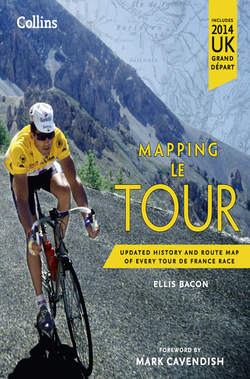Читать книгу Mapping Le Tour: The unofficial history of all 100 Tour de France races - Ellis Bacon - Страница 30
Оглавление1926
20th Edition
| Start: Évian, France, on 20 JuneFinish: Paris, France, on 18 July | |
| Total distance: 5745 km (3570 miles)Longest stage: 433 km (269 miles) | |
| Highest point:Col du Galibier: 2556 m (8386 ft)Mountain stages: 6 | |
| Starters: 126Finishers: 41 | |
| Winning time: 238 h 44’ 25”Average speed: 24.273 kph (15.082 mph) | |
| 1. Lucien Buysse (Bel)2. Nicolas Frantz (Lux) at 1 h 22’ 25”3. Bartolomeo Aimo (Ita) at 1 h 22’ 51” |
Radical changes the year previously turned yet more radical as the Tour started outside Paris for the first time. Évian, a town that had featured in the race for the first time only the year before – and best known today for its bottled water – was truly put on the map thanks to being used for the race’s Grand Départ. The race returned to its Paris start in 1927, however, where it remained until 1951, and a start in Metz. Only then did the race start in a different town or city each year, until 2003 when, for one year only, it started again in Paris, on the site of the Au Réveil Matin café, where it had started in 1903, to celebrate 100 years of the race. In a sad footnote, the building was gutted by fire in late 2003, barely two months after the Tour start.
At 5745 km (3570 miles), the 1926 edition was, and remains, the longest-ever Tour de France, although Desgrange dropped the total number of stages down to seventeen from eighteen the year before. He preferred longer, more epic stages, and judged the distances of the 1925 stages to be too short.
Thirty-three-year-old Belgian Lucien Buysse, second to Bottecchia in 1925, won overall in 1926, despite receiving the shocking news on stage 3 that his daughter had died. He only continued in the race after being encouraged to do so by his family.
His younger brother, 24-year-old Jules, had won the opening stage between Évian and Mulhouse by a massive 13-minute margin, and held yellow until stage 3. They became – and remain – the only brothers to wear the yellow jersey in the same edition of the race.
The Tour’s globalisation continued, too, when Kisso Kawamura became the first Japanese rider to take part – although he abandoned during the first stage.
Lucien Buysse powers to victory despite personal tragedy
